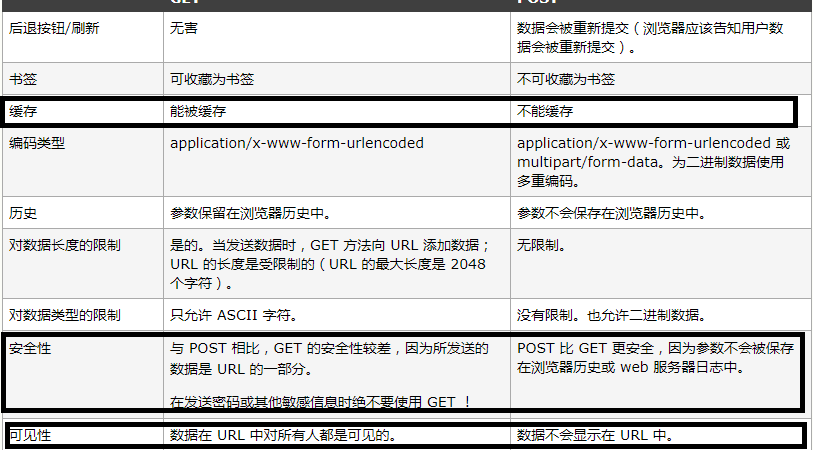前言:通过网上查询Android网络通信机制,大部分都是介绍这三种。因此,自己通过代码来实现网络通信。
首先先通过该网址 http://www.w3school.com.cn/tags/html_ref_httpmethods.asp 了解http中最常用的get和post请求区别。
一、标准的java接口(java.NET)
HttpURLConnection
HttpURLconnection是基于http协议的,支持get,post,put,delete等各种请求方式,最常用的就是get和post,下面针对这两种请求方式进行讲解。
HttpURLconnection是同步的请求,所以必须放在子线程中,下面以登录功能,来进行分析。(亲测)
private String getUrl = "网址/login.shtml?loginName=xxxxx&password=xxxxx";
private String headUrl = "网址/login.shtml";
MyHttpURLConnection( ) {
new Thread(new Runnable() {
@Override
public void run( ) {
try {
URL url = new URL(getUrl);
//得到connection对象。
HttpURLConnection connection = (HttpURLConnection) url.openConnection();
//设置请求方式
connection.setRequestMethod("GET");
connection.setConnectTimeout(3000);//连接的超时时间
//连接
connection.connect();
//得到响应码
int responseCode = connection.getResponseCode();
if (responseCode == HttpURLConnection.HTTP_OK) {
//得到响应流 connection.getInputStream()只是得到一个流对象,并不是数据,从这个流对象中只能读取一次数据,第二次读取时将会得到空数据
InputStream inputStream1 = connection.getInputStream();
//将响应流转换成字符串
String result1 = stream2String(inputStream1);//将流转换为字符串。
Log.d("getHttpURLConnection","result=============" + result1);
}
} catch (Exception e) {
e.printStackTrace();
}
}
}).start();
new Thread(new Runnable() {
@Override
public void run( ) {
try {
URL url = new URL(getUrl);
HttpURLConnection connection = (HttpURLConnection) url.openConnection();
connection.setRequestMethod("POST");//设置请求方式为POST
connection.setConnectTimeout(3000);//连接的超时时间
connection.setDoOutput(true);//允许写出
connection.setDoInput(true);//允许读入
connection.setUseCaches(false);//不使用缓存
connection.connect();//连接
int responseCode = connection.getResponseCode();
if (responseCode == HttpURLConnection.HTTP_OK) {
InputStream inputStream = connection.getInputStream();
String result = stream2String(inputStream);//将流转换为字符串。
Log.d("postHttpURLConnection1","result=============" + result);
}
} catch (Exception e) {
e.printStackTrace();
}
}
}).start();
new Thread(new Runnable() {
@Override
public void run( ) {
try {
URL url = new URL(headUrl);
HttpURLConnection connection = (HttpURLConnection) url.openConnection();
connection.setRequestMethod("POST");
connection.setDoOutput(true);
connection.setDoInput(true);
connection.setUseCaches(false);
connection.connect();
String body = "loginName=xxxx&password=xxxx";
BufferedWriter writer = new BufferedWriter(new OutputStreamWriter(connection.getOutputStream(),
"UTF-8"));
writer.write(body);
writer.close();
//post Json数据
// connection.setRequestProperty("Content-Type", "application/json;
// charset=utf-8");//设置参数类型是json格式
// connection.connect();
// String body = "{userName:xxxx,password:xxxx}";
// BufferedWriter writer = new BufferedWriter(new OutputStreamWriter
// (connection.getOutputStream(), "UTF-8"));
// writer.write(body);
// writer.close();
//post上传文件
// connection.setRequestProperty("Content-Type", "file/*");//设置数据类型
// connection.connect();
// OutputStream outputStream = connection.getOutputStream();
// FileInputStream fileInputStream = new FileInputStream("file");//把文件封装成一个流
// int length = -1;
// byte[] bytes = new byte[1024];
// while ((length = fileInputStream.read(bytes)) != -1){
// outputStream.write(bytes,0,length);//写的具体操作
// }
// fileInputStream.close();
// outputStream.close();
int responseCode = connection.getResponseCode();
if (responseCode == HttpURLConnection.HTTP_OK) {
InputStream inputStream = connection.getInputStream();
String result = stream2String(inputStream);//将流转换为字符串。
Log.d("postHttpURLConnection2","result=============" + result);
}
} catch (Exception e) {
e.printStackTrace();
}
}
}).start();
}
/**
* 将get获取的字节流转换为字符串
* @param is
* @return
* @throws IOException
*/
private String stream2String(InputStream is) throws IOException {
if (is != null) {// ByteArrayOutputStream好处:边读,边缓冲数据// 可以捕获内存缓冲区的数据,转换成字节数组
ByteArrayOutputStream baos = new ByteArrayOutputStream();
byte[] buffer = new byte[1024];
int temp = -1;
while ((temp = is.read(buffer)) != -1) {
baos.write(buffer,0,temp);
}
is.close();
baos.close();
return baos.toString();
}
return null;
}
以上是简单的HttpURLConnection数据请求,得到的结果是一样的,通过以上代码可以清晰的看得出,post和get请求数据的基本差异,以及它们通过网址的不同请求。
以下是http://www.w3school.com.cn/tags/html_ref_httpmethods.asp中的关于post和get请求区别列表
图上标记为目前我所能看到和实现的。
socket(这个比较特殊,下次有空详细介绍)
二、Apache接口(org.apache.http)
HttpClient
private String getUrl = "网址/login.shtml?loginName=xxx&password=xxx";
private String headUrl = "网址/login.shtml";
private final BasicCookieStore cookieStore = new BasicCookieStore();
private HttpResponse getResp;
private HttpResponse postResp;
private HttpClient mHttpClient;
public MyHttpClient( ) {
new Thread(new Runnable() {//get请求数据
@Override
public void run( ) {
mHttpClient = new DefaultHttpClient();
// 保持和服务器登录状态一直是登录着的,必不可少设置全局唯一的Cookie(不了解这步的意图,加不加都可get数据)
((AbstractHttpClient) mHttpClient).setCookieStore(cookieStore);
HttpGet httpGet = new HttpGet(getUrl);
httpGet.addHeader("contentType","application/json");
try {
getResp = mHttpClient.execute(httpGet);
if (getResp.getStatusLine().getStatusCode() == 200) {
String result = EntityUtils.toString(getResp.getEntity());
Log.i(TAG,"get请求结果: " + result);
} else {
Log.i(TAG,"get请求结果: error");
}
} catch (IOException e) {
e.printStackTrace();
}
}
}).start();
new Thread(new Runnable() {//post请求数据
@Override
public void run( ) {
mHttpClient = new DefaultHttpClient();
// 保持和服务器登录状态一直是登录着的,必不可少设置全局唯一的Cookie
((AbstractHttpClient) mHttpClient).setCookieStore(cookieStore);
HttpPost httpPost = new HttpPost(getUrl);
httpPost.addHeader("contentType","application/json");
try {
postResp = mHttpClient.execute(httpPost);
if (postResp.getStatusLine().getStatusCode() == 200) {
String result = EntityUtils.toString(postResp.getEntity());
Log.i(TAG,"post请求结果: " + result);
} else {
Log.i(TAG,"post请求结果: error");
}
} catch (IOException e) {
e.printStackTrace();
}
}
}).start();
new Thread(new Runnable() {//post请求数据
@Override
public void run( ) {
//创建客户端对象
mHttpClient = new DefaultHttpClient();
//创建post请求对象
HttpPost httpPost = new HttpPost(headUrl);
//封装form表单提交的数据
BasicNameValuePair basicNameValuePair1 = new BasicNameValuePair("loginName","xxx");
BasicNameValuePair basicNameValuePair2 = new BasicNameValuePair("password","xxx");
List parameters = new ArrayList<>();
//把BasicNameValuePair放入集合中
parameters.add(basicNameValuePair1);
parameters.add(basicNameValuePair2);
try {
//要提交的数据都已经在集合中了,把集合传给实体对象
UrlEncodedFormEntity entity = new UrlEncodedFormEntity(parameters,"utf-8");
//设置post请求对象的实体,其实就是把要提交的数据封装至post请求的输出流中
httpPost.setEntity(entity);
//3.使用客户端发送post请求
postResp = mHttpClient.execute(httpPost);
if (postResp.getStatusLine().getStatusCode() == 200) {
InputStream result = postResp.getEntity().getContent();
Log.i(TAG,"post请求结果: " + getTextFromStream(result));
} else {
Log.i(TAG,"post请求结果: error");
}
} catch (Exception e) {
// TODO Auto-generated catch block
e.printStackTrace();
}
}
}).start()
}
/**
* 字节流转换为字符串
* @param result
* @return
*/
private String getTextFromStream(InputStream result) {
byte[] b = new byte[1024];
int len = 0;
ByteArrayOutputStream bos = new ByteArrayOutputStream();
try {
while ((len = result.read(b)) != -1) {
bos.write(b,0,len);
}
String text = new String(bos.toByteArray());
bos.close();
return text;
} catch (IOException e) {
// TODO Auto-generated catch block
e.printStackTrace();
}
return null;
}
以上是HttpClient的get和post请求数据,简单的三种数据请求,得到的结果相同,在httpClient中post和get请求数据除了HttpPost 和httpGet的对象不同,其余的没有什么差异,不过也能实现上图中get和post的区别表中的特性。
三、Android.net网络接口
对于android.net网络接口本人不了解,但从网上查询了解了一下之后,知道这就是一个api接口,android自带的接口,常常使用此包下的类进行Android特有的网络编程,如:访问WiFi,访问Android联网信息,邮件等功能。这个我用的比较少,一般用的都是别人写好的。
private Context mContext;
AndroidNet(Context context) {
this.mContext = context;
}
/**
* 确定您是否连入了互联网
* 如果您未连入互联网,则无需安排基于互联网资源的更新。 下面这段代码展示了如何利用 ConnectivityManager 查询活动网络并确定其是否连入了互联网。
* @return true 已连接
*/
private boolean IsNoConnected( ) {
ConnectivityManager cm =
(ConnectivityManager) mContext.getSystemService(Context.CONNECTIVITY_SERVICE);
NetworkInfo activeNetwork = cm.getActiveNetworkInfo();
boolean isConnected = activeNetwork != null && activeNetwork.isConnectedOrConnecting();
//是否是wifi
//boolean isWiFi = activeNetwork.getType() == ConnectivityManager.TYPE_WIFI;
return isConnected;
}
这个 https://developer.android.google.cn/reference/android/net/wifi/package-summary
网址是官网提供的,里面有对android.net的详解
以上是我对于通信机制类型的简单了解,若有补充不到或理解有误的地方,望赐教。

